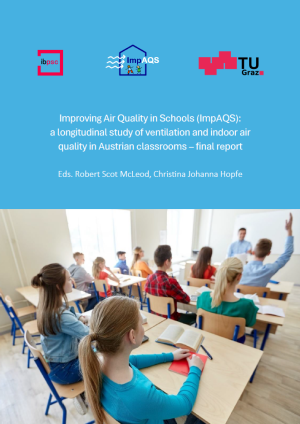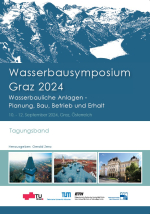mpAQS (Improving Air Quality in Schools) investigated CO2 concentrations, ventilation rates, and indoor and outdoor environmental data in 1200 Austrian classrooms spread over the 9 federal regions of Austria, across the 2023–24 school year. The study also evaluated the benefit of installing CO2 monitors in classrooms as a means of improving ventilation practices and reducing the risk of airborne disease transmission. The study was funded by the BMBWF and is one of the largest and most comprehensive studies of ventilation and air quality carried out in Austrian schools to date.
The CO2 data recorded by the ImpAQS project indicates a widespread failure to comply with existing European and Austrian ventilation guidelines in schools. The results showed that less than 25% of the schools are able to maintain an annual daily mean CO2 concentration below the existing 1000 ppm (BMK, 2024) guideline threshold. Whilst for more than a quarter of the school year the recommended minimum outdoor airflow rate of 4 l/(s·person) (EN 16798 1:2024) is not met. During the winter season the situation is even worse with less than 12% of schools maintaining a daily mean CO2 concentration below the 1000 ppm threshold.
Significant disparities exist between schools where the daily mean difference between the 10 best and 10 worst performing schools is more than 1000 ppm in winter-time. Significant differences were also found on the basis of school type, federal state, and ventilation type. Notably, there is not a single school that performed consistently within the existing guidelines all-year around. In the worst cases hourly mean CO2 values were found to be nearly 7‑times higher than the guideline threshold (exceeding 6900 ppm) over some teaching periods (with even higher values recorded over shorter time intervals).
Qualitative surveys carried out alongside the quantitative monitoring showed that ventilation practices are strongly influenced by two main factors: the room air temperature and external noise. In many cases physical obstructions were found to hinder appropriate natural ventilation (including window restrictors or unsecured inward-opening windows colliding with desks). Factors that influence compliance with CO2 targets include the occupant density (number of students per classroom), external and internal air temperatures, and the ventilation method (mechanical or natural). For example, when the outside air temperatures are 10 °C or below, mechanically ventilated classrooms have on average 450–600 ppm lower daily mean CO2 concentrations than naturally ventilated schools. Whilst mechanically ventilated schools performed better overall, three naturally ventilated schools ranked amongst the top 10 best-performing schools. Their low CO2 readings can be traced back to the occupants’ diligent window opening behaviour, higher than average spatial densities in classrooms (more than 3.2 m2 per child) and large unrestricted window openings. It should also be noted that in some cases mechanical ventilation systems were permanently switched-off, due to high running costs, highlighting a major barrier to their use in financially constrained schools.
Four key outdoor air pollutants (PM2.5, PM10, NO2, O3) where assessed in proximity to the ImpAQS schools using data from the Federal Environment Agency (UBA). The results show that the majority of measurement stations exceed both the World Health Organization (WHO) air quality guidelines reference levels for each pollutant, with some locations having mean values above thresholds which should not be breached more than 3 times per year. Despite these finding, teachers did not identify outdoor pollution to be a major hindrance to opening windows. This situation suggests that the use of mechanical ventilation with appropriate particulate and activated carbon filters should be recommended to help safeguard the health of students and staff in the worst affected schools.
Analytical infection risk modelling of the SARS-CoV-2 virus showed that classrooms with lower annual mean CO2 rates (and correspondingly higher airflow rates) have a much lower year-around infection risk.
The results showed that increasing the ventilation rate from 7.4 l/(s·person), the annual mean of daily ventilation rates in the sample, to 14 l/(s·person) could reduce the risk of at least one person in a classroom being infected during the school day by approximately 30%. That risk could be further reduced by about 45% using higher ‘health-based’ ventilation rates (such as those advocated by ASHRAE Standard: 241) with a minimum equivalent airflow rate of 20 l/(s·person), wherein a component of that airflow can also be sourced from recirculating air cleaned by HEPA filters. These calculations assume one infected person in a classroom of 25 people, a worst-case scenario that would only occur under certain conditions, such as during a peak of a COVID-19 wave. As such, these estimates represent potential risks rather than daily in-situ probabilities. Pearson correlation analysis revealed a moderate association between infection risk and absenteeism (0.554) across the school year. This finding may have been influenced by the reduced absenteeism dataset (wherein only 40% of schools submitted information) and by the fact that only associations with SARS-CoV-2 were investigated, but not other circulating airborne viruses.
The use of visible CO2 monitors and ventilation guidance made a significant difference to the ventilation practices in naturally ventilated classrooms compared to similar classrooms without any visible information. In January, a quarter of naturally ventilated classes with visible CO2 monitors reported CO2 concentrations that were 500 ppm lower than the corresponding classrooms without visible monitors. This finding demonstrates the value of using CO2 sensors (with visible traffic light systems), particular during the colder months, in naturally ventilated classrooms.
Generally, the installation of CO2 monitors was perceived very positively by the majority of classroom teachers and school directors. An increase in the number of classroom CO2 champions (students alerting teachers to ventilate on a regular basis) was seen over the project duration. It should be noted that no additional training was provided to the participating classes in relation to the correct use of the CO2 sensor or ventilation strategies. Therefore, it is anticipated that with appropriate training the full benefit of students and teachers engaging in the ventilation process is likely to be much greater than demonstrated in the outcomes of this study.
The findings of the ImpAQS study have national and European significance in raising awareness of the urgent need to improve ventilation and air quality in schools. The results provide actionable information that should be used to improve learning outcomes, health and wellbeing of school students and staff across Austria. Compliance with existing guidelines and standards should be seen as the first step towards a future where ‘health-based’ ventilation practices become the norm. To avoid further inequities in existing ventilation practices, the authors believe that responsibility for this transition cannot be delegated to individual schools but must be part of a nationally coordinated process.






